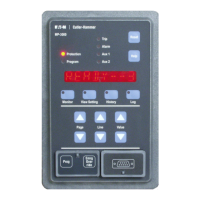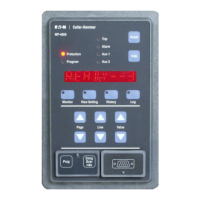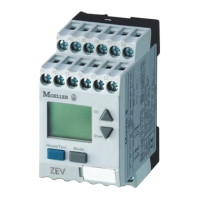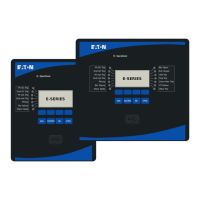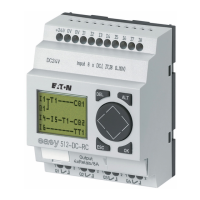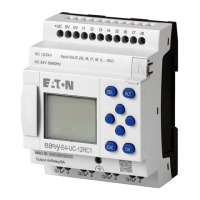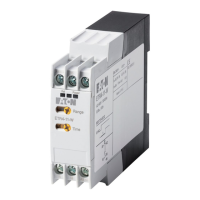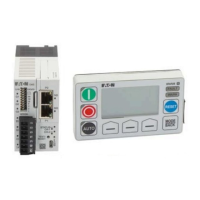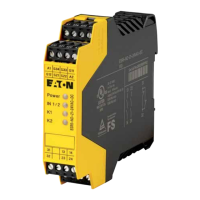Page 5-8
Effective 10/02For more information visit: www.cutler-hammer.eaton.comIL17562BH04
5.5.12 Setting P5L12, Anti-Backspin Delay Time (ABK)
Sets the time in seconds before a motor restart is permitted after a trip
or stop condition. This function can be set to OFF.
This function is used with a motor driving a pump working into a head,
or any other load which tends to spin in a reverse direction (backspin)
when the motor is de-energized. It blocks starting during the time
when the motor might be rotating in reverse following a trip. Also, this
function may be used simply to set idle time (time between stop and
start) before a restart is permitted.
5.6 Page 6, SP DI 1
This page contains the single setting which configures Discrete Input 1
(DI 1). The input must be a 120 Vac signal. A 120 Vac source for
wetting dry contacts is provided on the MP-3000 terminal block for
convenience. Refer to wiring diagrams in Section 6.
5.6.1 Setting P6L1 (REM RST, REM TRIP, DIF TRIP, MTR STOP,
RST DBL, EMG OVR, or ZERO SW)
If the zero speed switch (ZSW) function is ON in the SP START page
(P5L11), then this DI 1 input is automatically configured to be zero speed
switch contact input, ZERO SW, and no other setting option is visible.
If ZSW is set to OFF, then the available choices for Discrete Input 1 are:
REM RST–Remote Reset—When voltage is applied, the MP-3000
resets its active functions and displays, just as if the reset pushbutton
on the faceplate were pressed.
REM TRIP–Remote Trip—When voltage is applied, the MP-3000 trips
the motor and displays the message “REMOTE”. The trip will reset
only if the input voltage is removed.
DIF TRIP–Differential Trip—When voltage is applied, the MP-3000
trips the motor and displays the message “DIF TRIP”. This is used
with an external motor differential relay whose trip contact is normally
open, but closes when it detects a fault. The trip can be reset only
after the voltage is removed. Can be used for tripping by any auxiliary
function with a normally open contact.
MTR STOP–Motor Stop Detection Blocking—With this setting, a
voltage input to DI 1 will keep the MP-3000 in the RUN mode even
when the motor current drops below 100 mA secondary. This feature
is used mainly with a synchronous motor operating as synchronous
condenser, for power factor correction. The current may approach
zero during normal sustained operation.
RST DBL–Reset Disable—With this setting, the MP-3000 front-panel
Reset pushbutton is disabled following a trip or alarm condition. The
only way to reset the unit is by applying voltage to DI 1. This feature
prevents unauthorized personnel from resetting the relay or restarting
the motor after a trip. Use a secure reset contact to apply voltage to
DI 1.
EMG OVR–Emergency Override—On DI 1 voltage input, the
MP-3000 will perform as if the emergency override pushbutton were
pressed.
5.7 Page 7, SP DI 2
This page contains the single setting which configures Discrete Input 2
(DI 2). The input must be a 120 Vac signal. A 120 Vac source for
wetting dry contacts is provided on the MP-3000 terminal block. Refer
to wiring diagrams in Section 6.
5.7.1 Setting P7L1 (INC SEQ, REM RST, REM TRIP, DIF TRIP,
MTR STOP, RST DBL, or EMG OVR)
If the incomplete sequence function INSQ is on and set for some time
delay (P5L8), then DI 2 is automatically configured to control incom-
plete sequence timing, INC SEQ, and no other setting is possible.
If INSQ is turned OFF, the other choices for DI 2 are available. These are
the same choices as for Discrete Input 1, P6L1, Section 5.6.1 just above.
5.8 Page 8, SP AREL, Settings P8L1 to P8L22
Use this page to configure which events activate the alarm relay.
The factory default setting is for every alarm event to activate the alarm
relay; and for the alarms to reset automatically when the condition
disappears. Trip events do not activate the alarm relay; nor does Time
Between Starts blocking, which frequently goes true during normal
operating cycles. Check the settings to be sure they agree with factory
defined values (see column in Table 4.3) or change as needed.
NOTE
EVEN THOUGH A PARTICULAR ALARM CONDITION IS DIRECTED
TO THE ALARM RELAY ON THIS PAGE, IT CAN FUNCTION ONLY
IF IT IS TURNED ON IN THE SP ALARM PAGE 4.
Settings control the following 22 alarm assignments. Any or all can be
turned OFF:
• Ground fault alarm, or trip
• I2T alarm, or trip
• Jam alarm, or trip
• Underload alarm, or trip
• Phase unbalance alarm, or trip
• Winding temperature alarm, or trip (with URTD)
• Motor bearing temperature alarm, or trip (with URTD)
• Load bearing temperature alarm, or trip (with URTD)
• Auxiliary temperature alarm, or trip (with URTD)
• Starts per time alarm, or trip
• Time between starts trip
• Individual RTD channel failure alarm
• URTD overall communications failure alarm
• IOC trip
• Phase reversal trip
• Incomplete sequence trip
• Remote trip (via discrete input)
• Differential trip
• INCOM (data communications) trip
• Transition trip
• Zero speed switch trip
• Trip bypass (contactor fails to interrupt current after trip)
5.9 Page 9, SP AUX1, Settings P9L1 to P9L25
Use this page to configure which events activate the AUX1 output relay. It
also includes the three settings to configure the load shedding function.
The factory default setting is for a thermal trip (I2T trip) only to pick up
this relay. Many users will choose to change this. If the load shed
function is turned on, using settings P9L1 to P9L3 as explained next,
